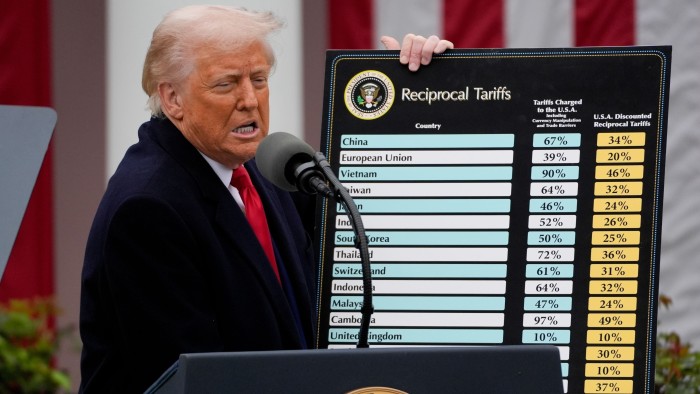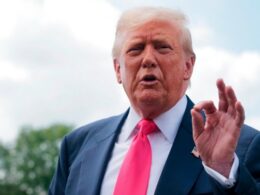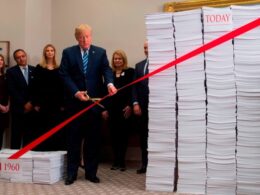This article is an on-site version of our FirstFT newsletter. Subscribers can sign up to our Asia, Europe/Africa or Americas edition to get the newsletter delivered every weekday morning. Explore all of our newsletters here
Good morning and happy Friday. Donald Trump’s sweeping tariffs have ignited Wall Street’s steepest sell-off since the 2020 Covid crisis. We have more on the US president’s trade war below. Also in today’s newsletter:
-
Why Fitch downgraded China’s sovereign debt
-
Samsung turns to Chinese tech groups to boost chip sales
-
Japan’s safety deposit box problem
US President Donald Trump’s barrage of tariffs is set to land hardest on Asian manufacturing, throwing into disarray supply chains rejigged only recently to work around tensions with China.
What’s the scale of the tariffs?: The Trump administration’s “reciprocal” tariffs bring the rate on imports from China to more than 60 per cent, representing the highest levels imposed on the region. But manufacturers and economists said new tariffs of between 32 and 49 per cent on many south-east Asian economies came as a much bigger shock, undermining the “China plus one” strategy of using them as a second export manufacturing base.
“The tariffs hit ‘Factory Asia’ hard,” Citi analysts said in a research note.
A blow to Vietnam: The country, the first and largest beneficiary of the “China plus one” strategy, is expected to be the worst hit: it faces a 46 per cent tariff rate and is more exposed to the US market than most other Asian exporters.
“US exports account for 30 per cent of [Vietnam’s] GDP,” Bernstein analysts said, adding that the new tariffs could shave up to 6 per cent off the country’s output.
Which goods will be most affected?: Smartphones, computers and other electronic gadgets, which accounted for 30 per cent of Vietnam’s exports to the US last year, are expected to take the biggest hit. Supply chains for clothing and shoes, with Vietnam the largest source of US imports after China, are also expected to be disrupted.
Opportunity for India?: The country got off comparatively lightly, with a 27 per cent tariff rate. Compared with the higher combined tariffs China and Vietnam are facing, India would enjoy a “valuable near-term window of export competitiveness”, Pankaj Mohindroo, chair of the India Cellular & Electronics Association, told the Financial Times. But Mohindroo said the “true long-term inflection point” for India’s electronics industry would rest on the successful conclusion of a US-India bilateral trade agreement.
Read more about Trump’s tariffs and their implications for Asia. And see more news and analysis on the fallout below:
-
US-China relations: Trump’s latest tariff attack on China could imperil any possible “grand bargain” between Washington and Beijing.
-
How Trump’s tariffs were calculated: Trade economists have poured scorn on the crude methodology used by the president’s administration to calculate the list of “reciprocal” global tariffs.
-
Apple pummeled: The iPhone maker lost more than $300bn in market value yesterday, making it one of Wall Street’s biggest casualties of Trump’s tariff blitz.
-
EU response: Brussels has given itself a four-week window to convince Trump to drop his 20 per cent tariffs on the bloc, with retaliation ruled out before late April.
-
Opinion: Trump’s tariffs are an economic emergency that will only hurt Americans, writes Michael Strain.
Here’s what else we’re keeping tabs on today and over the weekend:
-
South Korean politics: The Constitutional Court rules on whether to uphold suspended president Yoon Suk Yeol’s impeachment or return him to office after the conservative leader’s failed bid to impose martial law last year.
-
Economic data: Thailand and the Philippines report March CPI inflation figures today. Vietnam on Sunday releases a batch of data, including March CPI and first-quarter GDP.
-
TikTok deal: The deadline for a sale of the video platform’s US operations is on Saturday, when a federal law would ban the app in the country unless its Beijing-based owner sells the American arm to non-Chinese entities.
How well did you keep up with the news this week? Take our quiz.
Five more top stories
1. Rating agency Fitch has downgraded China’s sovereign debt over concerns about weaker public finances and the impact of higher tariffs on exports. Fitch said its move reflected expectations that China would sharply increase spending in order to support economic growth and counter deflationary pressures. Beijing denounced what it said was a “biased” downgrade.
2. Samsung has turned to Chinese technology groups to prop up its ailing semiconductor division as it struggles to secure big US customers. In one previously unreported deal, the South Korean company last year sold more than three years’ supply of logic dies — a key component in manufacturing AI chips — to a subsidiary of China’s Baidu.
3. Oil prices tumbled yesterday and producers’ shares slid as Opec+ unexpectedly announced plans to boost crude output. Eight Opec+ members, including Saudi Arabia and Russia, said they would triple a planned increase in oil production in May, bringing forward a commitment to reverse production cuts over the next 18 months. The move came as Trump’s new tariffs stoked fears of a global economic slowdown.
4. Trump has fired a number of senior officials of his National Security Council after a far-right activist and conspiracy theorist claimed they were disloyal to his “Make America Great Again” agenda. The sackings come as national security adviser Mike Waltz faces pressure after discussing military strikes in a Signal group chat.
5. Klaus Schwab, the founder of the World Economic Forum, will “start the process” of stepping down as chair of its board of trustees. The move comes weeks after the organisation promised an overhaul following an investigation into workplace discrimination. Here’s what Schwab wrote in a letter to trustee board members.
The Big Read

Trump’s rapid rapprochement with his Russian counterpart Vladimir Putin and apparent disdain for many of America’s Nato allies is causing consternation across central Europe. The move may suit the leaders of countries such as Hungary and Slovakia, but for the likes of Poland, Romania and the Czech Republic, it is causing ruptures to domestic politics.
We’re also reading . . .
-
Trump’s TikTok dealmaking: The president has talked tough on restricting US money into adversaries’ tech, writes Chris Miller, but TikTok puts money into China’s AI ecosystem every day.
-
Danantara: Indonesia’s new sovereign wealth fund is a project of surpassing ambition, writes Robin Harding. But does it make sense?
-
Japan’s safety deposit box thefts: Several grubby scandals have cast a shadow over a banking industry already under scrutiny, writes David Keohane.
Nikkei, the Financial Times and Peter Fetterman Gallery present Japan / A Love Story, featuring Michael Kenna’s evocative photography of Japan’s landscapes and culture. Visit H Queen’s in Hong Kong from 25 April to 18 May.
Chart of the day
The latest round of new tariffs unleashed by Donald Trump will hit almost every industry across the globe. But business leaders warn that the biggest victim will be US consumers, who will be paying more for everything from Adidas trainers to Modelo, the country’s top-selling beer.
Take a break from the news . . .
The shoulder pad is back. Much maligned, often misused, the wardrobe staple of the 1980s is being revived with gusto some 40 years after the height of its popularity — and this time, it looks bigger than ever.

Source link










